| | |
The boars are about as smart as the average cement extruder, and aren't good for much besides getting into fights and making little Gamorreans.Callista Ming
Gamorreans (derogatorily known as pig-lizards) were porcine, brutish humanoids from Gamorr, a lush jungle-world in the Outer Rim. Gamorr's technological level was equivalent to the low-tech periods which Human civilizations had experienced circa 25,000 BBY. The Gamorreans colonized the planet Pzob in the K749 system, and were the majority sentient species on Lanthrym in the Elrood sector. Their vessels provided only essential amenities, in addition to shields and weaponry. Gamorreans were typically green-skinned, with a large and powerful physique; they had a well-deserved reputation as fierce warriors, prized much more for their strength and personal combat prowess than for their wits. They were organized into clans headed by a Council of Matrons. In Gamorrean society, sows (females) performed all the productive work, while the boars (males) concentrated on martial training and waging war. They spoke Gamorrese (also called Gamorrean). One of their favorite weapons was a traditional war axe called an arg'garok, which was designed specifically for beings with extraordinary strength as well as a low center of gravity. (They could, however, point and shoot if someone shoved a blaster into their hands.)
The Galactic Registry entry for Gamorreans on Pzob was 011-733-800-022.
Biology and appearance
Skinny v'lch. Not find husband, all skinny. Morrts can't live on skinny. Feed you. Make you Gweek. Good husband; two tuskers; nine morrts.Captain Ugmush suggests making Callista Ming into a proper Gamorrean sow
Gamorrean males averaged about 1.8 meters in height and could weigh more than 100 kilograms. They had thick snouts, close set eyes, tusks, and two small horns on their heads. Their average body temperature was 40.56 °C (105 °F) and their verbal tones ranged from 50 to 13,000 hertz.
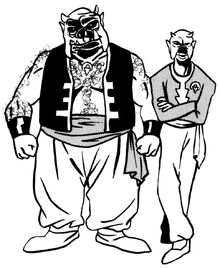
Although a typical Gamorrean was squat, green, and heavily built, not all shared these characteristics. Most Gamorreans had a dark greenish coloration over a large portion of their bodies; however skin coloration did vary, particularly among females, with light skinned and two-toned pigmentation not uncommon. Black, brown, pinkish yellow, and even a rare white pigmentation were possible. Boars tended to have less skin variation and had a greater tendency towards dark green skin, perhaps because of their higher exposure to the radiation of the Gamorr Star. Eye coloration varied evenly between gold-yellow, blue, black, and brown. The Gamorreans generally put no importance on skin or eye coloration, although there were some superstitions linked to certain markings.
Not all Gamorreans were heavy and squat. Although this was the most common and generally the desirable appearance in Gamorrean society, some individuals were comparatively lean and tall. Greel, co-owner of the The Broken Tusk on Reuss VIII, was quite undersized compared to his brother Gorge, who represented a more conventional Gamorrean appearance.[5]
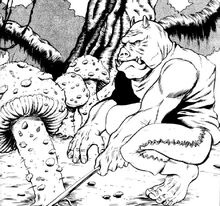
They were largely viewed as mindless, intellectually inferior brutes by the wider galactic community. This perception may have been partly due to their physiology, which made it nearly impossible for them to speak Galactic Basic. Their vocal apparatus made it almost impossible for them to speak clearly in any language other than their native language. However, there were some exceptions: Captain Griknaz was able to do so clearly.[6]
Gamorreans were typically covered by a number of parasitic bloodsuckers native to Gamorr called morrts. They showed great affection for the creatures and considered them adorable pets. The number of morrts that a Gamorrean hosted was related to their status within a clan. A clan Warlord or Matron could have up to 20 of these parasites feeding on them.
The Gamorrean diet mainly consisted of fungus that grew plentifully on their homeworld. A species of mobile mushrooms called Snoruuk was one of the most widely eaten varieties, along with Fug. They drank an alcoholic beverage called Potwa beer.[7]
Newly born Gamorreans were called "feeders" until they were weaned. Once weaned, the younglings were called "shoats" until the age of 3 when they began gender-specific training. Gamorrean childhood ended after about 6 years, from which point they were considered young adults. When they reached the age of 13 they were considered mature adults and the boars would go to war. Biologically they were capable of living beyond the age of 45, but the violent nature of their existence meant that very few boars reached that age.
Society and culture
Clan Society
All this—gweek. Husbands and tuskers and fields and children—gweek. Sometimes … I want gweek. Gweek for me. More so in slushtime, in the cold and the dark.Kufbrug
Gamorreans were organized into clans ruled by a male warlord and his wife, a head sow who was the most powerful of the clan matrons. While the warlord and his boars were solely concerned with preparing and participating in battle with rival clans, the matrons of the clan performed all the productive work including farming, hunting, manufacturing weapons and running businesses.
Gamorrean sows
Stupid, Aurra! Should have checked for that storm! Making mistakes like some Gamorrean sow!Aurra Sing talking to herself on Tatooine 32 BBY
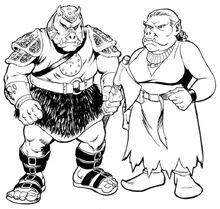
Females within a clan were all related to each other and could trace their lineage back to a common matriarch. Boars, however, were exchanged between clans at an early age and some would change their allegiance during their adult lives. Clans ranged in size from a few dozen to over a hundred but typically a clan constituted about 20 sows, 50 boars and the young, making 71 Gamorreans in total. The young were mostly born in the spring ("slushtime") and the litters typically ranged between three and nine. The male to female ratio was about ten-to-one with females only being born about every second litter. Despite this, a high fatality rate among boars, due to their violent lives, resulted in a predominance of older females.
Clans owned and controlled areas of land and were always interested in acquiring more. Land was gained by either colonizing unclaimed areas or more commonly taking land from rival clans. Since the amount of available arable land on Gamorr was scarce several clans often laid claim to the same piece of land, and they spent their time fighting over possession. A female typically had up to a dozen husbands during their lifetime since a boar's lifespan was limited by his violent lifestyle.
Sows did all the useful work within Gamorrean society and they owned and leased all property. They were capable of being as rough as the males and they actively encouraged boars to engage in bloody act of violence to demonstrate their virility. Daughters inherited their mother's land evenly and therefore over generations these holdings diminished in size. A matron consolidating land was a critical reason for the ongoing wars between clans.
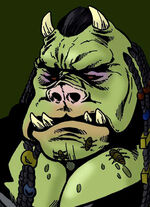
Clan matrons were a select group of sows with the greatest of land who constituted the clan council of matrons. They usually had a number of clan Tusker boars in admiration of their beauty and status. A matron could often be distinguished from a lesser clan sow by the presence of a small number of bodyguards and the relatively large number of morrts that they hosted. The council of matrons was led by a head sow who were the richest and most powerful of the clan matrons.
Sows were responsible for all trading with non-Gamorreans. They were typically interested in obtaining weapons and food supplies with long lives. They would pay for such goods with gold or other precious metals if they had any or by boar mercenary contract.
Gamorrean boars
There were four classes of male boars within Gamorrean society: Warlords, Clan boars, Tuskers and Veterans. Warlords were the most socially and physically powerful boars in a clan and held their position by way of their marriage to a clan matron. The greatest of the warlords was selected by the head sow for his combat prowess and past successes. He was absolute ruler in all matter of war and general of the clan armies. The lesser warlord served as clan captains. A typical warlord could host up to twenty morrts and they were known to bestow them on other warriors for acts of heroism. Warlords almost always came from the ranks of the household boars (otherwise known as Tuskers).
Clan boars were males married to clan sows (not matrons) and they made up the core of the clan-guard and the clan army. They were important individuals because the income provided by their wives enabled them to afford good weapons and armor. Their relatively high status (below warlords) was indicated by the 10 or so morrts that lived on their bodies. They could generally not attain the position of warlord unless their wife died and they married a matron or she inherited a matronage, both rare events in Gamorrean society.
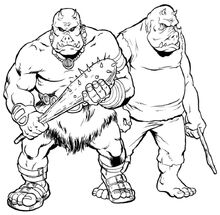
Tuskers or household boars were unmarried males who were pledged to a clan. They formed the bulk of the clan armies and generally lived off the plunder of military campaigns. While a tusker was customarily poor they could hope to gain the attention of a sow or perhaps even a clan matron and therefore enter the ranks of the Clan boars or Warlords. They typically hosted about half a dozen morrts but a successful tusker could amass a much larger trove. They would often give a clan matron their morrts as tribute. Tuskers were not totally loyal and would occasionally change their allegiance to another clan particularly if the clan matron was looking to increase the size of her clan.
The fourth basic variety of boars in Gamorrean society was the Veteran. They were retired from campaign due to old age or more commonly from a maiming or injury. A veteran could often be identified by the lack of a body part and the presence of about twelve or so morrts. They were typically very tough, experienced boars who were well respected within their clan. They were responsible for the training of the young boars before they first marched off to war and were trusted advisors to clan Warlords. They also often commanded the clan-guard.
Gamorrean youths often kept gelatinous slimes from the planet Saclas as pets.[9]
Clan fortresses
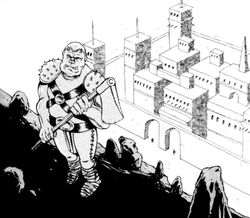
Gamorrean clans constructed fortresses that varied in size dramatically. They all tended to follow the basic design. The simplest fortresses consisted of a stockade surrounded by a small village of huts and long houses. The clan-guard controlled the boundary of the fortress and kept unwanted visitors away. They domesticated dangerous predators called Watch-beasts to help protect these strongholds. Access to the settlement was through a gate and at the center of the village was typically the clan-house. This was a well constructed, heavily fortified building where the matrons and warlords resided. A small fortress would be inhabited by about 10 sows and 20 boars, making 30 Gamorreans in total.
An average fortress consisted of a village with a stockade that could be surrounded by a moat or other boundary defense. An internal sub-fortress was usually built around the village on a built-up or naturally occurring mount.
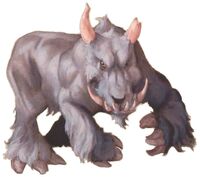
The sub-fortress was a well-built construction that was sometimes built of stone and it was well guarded. In its function, the sub-fortress was a large version of the clan-house. An average Gamorrean village of this size would typically be inhabited by between 30 and 50 sow and as many as 100 boars. Immediately inside the main gate of the village was located a common area. This was a place where markets were held and it represented a safe area for other clan members. It was a serious crime to violate the strict no fighting rules in this area.
Some of the most powerful and prestigious Gamorrean clans had larger fortresses that were effectively townships. The town was surrounded by an outer wall fortifications and a broad moat. It was often also divided internally by walls to reduce the impact of an enemy that advanced passed the main gate. There were several clan-houses in the internal structure and a sub-fortress that acted as a final refuge against an advancing army. Only about a dozen townships of this size existed on Gamorr and was populated by as many as 100 sows and 300 boars.
Several of these larger fortresses have constructed a foreigners' quarter within their boundaries where other clans could deal with each other in safety. Like the common area of smaller settlements there was a strict prohibition of combat in this area. Non-Gamorreans were often found trading in these areas. Most towns maintained a large landing field outside of their boundaries.
Some of the larger clan-towns formed sub-clans that still considered themselves part of the parent clan although local rivalries between sub-clans did develop. It was debated among Xenosociologists whether the development of these large clan-towns marked a societal change within the Gamorrean clan structure or whether these clan-towns would eventually collapse under population and social pressure.
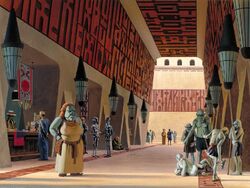
- Bolgoink clan (Gamorr)
- Bk'trugh clan
- Gakfedd clan (Pzob)
- Glonnk clan (Gamorr)
- Groogrun clan (Gamorr)
- Jugsmuk clan (Gamorr)
- Klagg clan (Pzob)
- Norgk clan (Gamorr)
- Rogak clan (Gamorr)
Some clans formed small professional mercenary bands that move around selling their combat services to the higher bidder. Although it was not exceptional for fashionable clans to occasionally fight for another clan for pay, these mercenary clans did it professionally. They were, however, not totally driven by greed and the warlords of these clans still adhered to the tradition of fighting a blood-battle to complete a deal. Since these clans would go somewhere to carry out a contract they constituted a significant quantification of Gamorrean mercenaries in the galaxy.
The warring clans of Gamorr never united under the banner of one planetary government and therefore the Gamorreans did not have representation in the Galactic Federation of Free Alliances[10].
Although Gamorreans were not known for their sensitive nature they were especially demonstrative when it came to their morrts and were particularly loving toward their children and mates. Signs of affection included a tackling hug and a punch on the snout. Indeed, knocking a mate unconscious was considered a prelude to mating, although the initiator had to make sure they had smelling salts at hand if copulation was the intention.
Calendar
Winter is when the boars can't get out and fight one another either, so they get all cozy and pleasant—they really do—and write songs and poems to their sows. Or, they hire me to write songs and poems.Sebastin Onyx
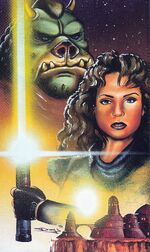
The activities of the Gamorrean clans on Gamorr were dominated by the seasons. Spring was called slushtime because of the melting of the winter snow and the abundance of rain and resultant perpetual mud. The wet conditions of early slushtime resulted in plentiful harvests of short-term fungi and provided a start for the longer growing moulds. During this period the veteran boars trained the younglings in combat and the unattached tusker boars roamed the land looking for adventure and opportunities. Early slushtime on Gamorr was a depressing time, the constant rain and dark gray skies often resulted in many Gamorreans feeling grumpy and miserable. Since Gamorreans idealized emotions of strength and ferocity it was not a polite subject to discuss their emotional degeneration in this regard. Most sows gave birth at this time which was about a gestation period from the return of the boars from campaigning in autumn. Mid-slushtime was also traditionally the time for marriage and for negotiating and finalizing Clan alliances and mercenary contracts. It was also the time when young boars were exchanged for fostering and the clan matrons readied their warriors for war in the summer. Toward the end of this season, clans tuskers tended to initiate raids against rival clans in order to prove their boarness.
The summer season was called Wartime and initiated a period of military campaigning, often in retaliation for the raids in late-slushtime. The boars, unmarried sows (sometimes derogatorily called "v'lch") and young boars in training marched off to war. They left behind the matrons, married sows, elders and a small guard of boars to defend the settlements and fortresses. The military strategy of Gamorrean warfare was quite basic and involved attacking, plundering and the occupation of land. In early-wartime the clans participated in a number of small scale battles during which time each side probed the strength of the opposition for weaknesses. By the middle of the campaigning season the Gamorrean warriors had settled into the business of besieging opponents fortresses and as the temperature increase toward late-summer grand battles were fought as forces attempted to break from a besieged position.
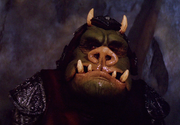
By the end of the summer period, the clans had spent the majority of their strength. There were a few late skirmishes in autumn (Croptime) as the clans made their way back to their homes in triumph or otherwise and by mid-croptime they had settled in for the winter. During this period, the sows and drafted tuskers harvested the crops and autumn fairs occurred as newly wealthy clans traded plundered goods and crops. The fairs also operated as a forum for the forming of new clan alliances. Also during this season, widowed sows advertised their availability and married, tales of heroic battles were told, wounded boars ceremoniously join the ranks of the veterans and the clans feasted for the last time before the coming of winter.
Winter was called Coldtime and was a period of freezing temperatures and fierce storms on Gamorr. Clans that were too depleted during the summer campaigning season would often find themselves starving and this sometimes resulted in sporadic winter raids. In the more successful and affluent clans, life was more comfortable. Boars became docile and romantic, courting their wives as young tusker males did. This behavior by the boars continued into early spring when the first seasons flowers were picked and presented as gifts to the sows. The unmarried tuskers spent the winter worshiping a matron from a distance, planning for the next seasons combat and playing table games. During the winter and early slushtime, some skilled Gamorreans would ride sleds pulled by semi-domesticated Dwoobs as a method for transporting goods. They were generally only used by skilled sled drivers and most used simple wheel-barrows to transport goods.
Beliefs
It is true also, V'Ich Muh, that Lady Gundruk, and Lugh, and others of the household have heard the spirit of Vrokk moving about at night in the room in which he died. Spirits only walk if murder was done.A scholar sow explains Gamorrean beliefs to Callista Ming
Gamorreans were Animistic and believed that everything such as natural features, animals, sites of past battles and people had an enduring spirit that could affect the physical worlds. The superstitious beliefs of the Gamorreans, however, decreased over the last hundred years or so before the Battle of Yavin. Although they believed that everything had a lingering spirit, they were generally only concerned with powerful spirits that could pose a threat.
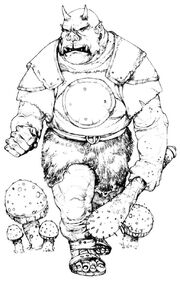
Famous long-dead heroes, giant trees, large fungi, the spirits of murdered individuals and ancient fortresses are an example of things that Gamorreans believed could help or hinder the living. The association with how these spirits affected the physical world was based on the nature of the source in Gamorreans lives. For example, tree and mountain spirits were generally considered good because the source, with which they reside, provides wood and stone for building. This, however, did not mean that they believed that they were totally benign since trees would drop branches on individual and mountains would shed landslides onto unsuspecting Gamorreans.
The spirits of the sea and forest were considered incomprehensible. Sometimes, they would let a traveler past and other times, they would hinder their progress. Forests were viewed as mischievous, they would change the path and, on occasion, swallow an entire fellowship whole. Gamorreans didn't like the oceans as they saw them as incredibly unpredictable. If treated correctly, they thought that the spirits would send favorable wind, and if angered, they would unleash a ferocious storm. Even if the spirits sent favorable wind and current they believed that the spirit, on occasion, decided to sweep the traveler far out to sea or draw the vessel into a watery grave.
They believed that ancient fortresses had powerful and good spirits that could fortify the strength of defenders during an attack. Famous warriors who fell during an attack on a fortress were also invoked to increase the defenders strength. Such spirits were thought to protect a certain clan and they also included a powerful warlord who fell in combat, who was invoked to ensure victory in battle, and most importantly the spirit of the clan founder. The clan founder was a matron and it was believed that she sent dreams to the incumbent clan matron to advice in time of strife.
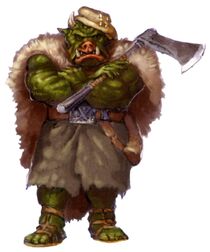
An ancient clan fortress and giant fungi were thought to house fertility spirits. In the case of the fortress spirit, it was believed to increase the fertility of sows during slushtime and croptime. They believed that giant carnivorous fungi, such as the Algark stalks, contained fertility spirits because they would dispense their spores (offspring) when approached. As such, the Gamorreans respected these spirits from afar.
The spirit of a murdered individual was greatly feared by most Gamorreans. They were thought to be angry at being killed by underhand means and intent on seeking revenge against the murderer. These spirits were believed to walk the land of the living during the night, seeking retribution and killing all that they came across. According to the Gamorrean beliefs, they were exceptionally strong and dangerous but did not possess supernatural abilities such as invulnerability or the ability to fly and could therefore be physically fought by a warrior. Since the surest way to prevent the spirit from entering the physical plane was to kill the murderer, justice was often swift on Gamorr and Pzob.
The fallen in great battles were thought to reside at the site of their demise and were believed to return during stormy winter weather to re-fight the battles. Since battles typically took place near settlements and fortresses, storm damage to these dwellings were often attributed to the spirits.
Combat and honor
Rog not happy, he said. Rog say, fight and kill Guth, fight and kill Ugmush, fight and kill you, then go home.A veteran warns Callista Ming
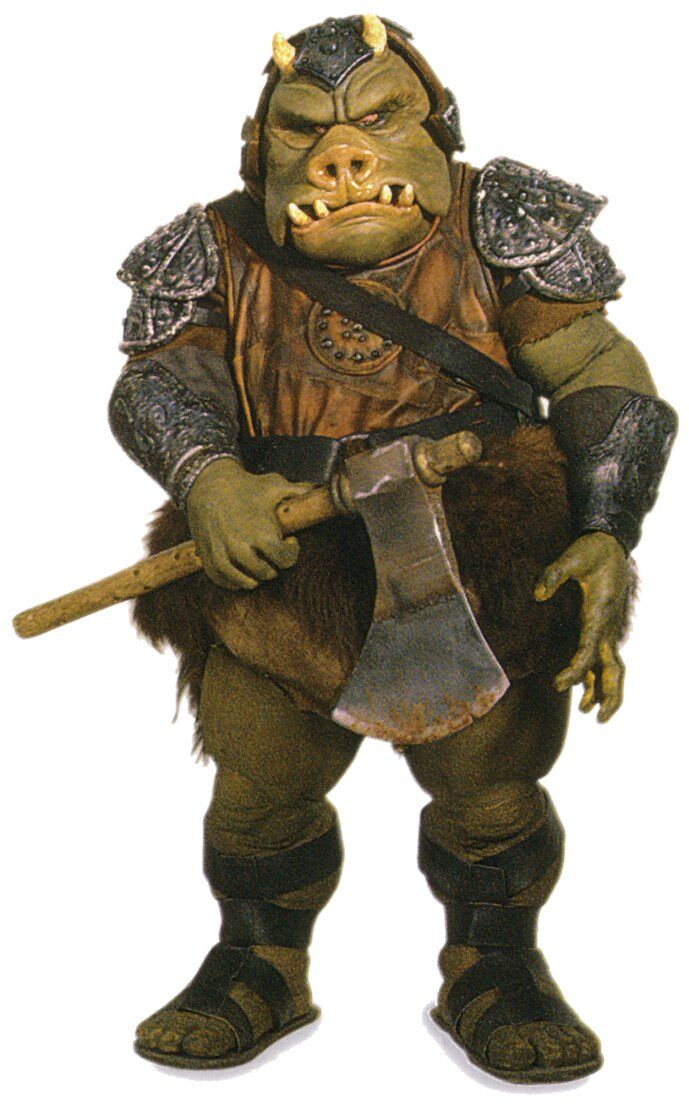
Gamorrean combat was almost entirely hand-to-hand with or without a melee weapons and typically relied on physical power. Clans in regular contact with offworlders did not consider vibro-blades as magical objects as they did for a long time, and their increase in cutting power was considered a sign that they were a superior weapon. Vibro-axes were popular weapons among the Gamorreans and two examples were the Arg'garok[11] and the Clan Groogrun vibro-ax[12]. The latter was built on Gamorr by members of the Groogrun clan, such as the master weapon-maker Snogrutt[13]. Another commonly used weapon was the Thogk, a traditional Gamorrean club that literally translated as "log with a spike in it". They were crafted with pride by pounding a metal spike through a long chunk of gorgt wood. Gamorreans also frequently wore armor called M'uhk'gfa. Traditionally, each suit of battle-plate was constructed from fragments of metals collected as trophies on a battlefield and bound by leather-straps. A segmented collar protected the neck while plates surrounded the torso and shoulders. Thinner plates were often attached to the arms that allowed a weapon to be freely swung. A helmet was also worn that took into account the Gamorreans horns. Since their introduction to the Republic, and later the Empire, the traditional skill of constructing M'uhk'gfa battle plates diminished and many Gamorreans started to acquire pre-fabricated armor.
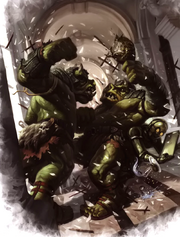
The Gamorreans had little interest in ranged weapons, such as blasters. When Republic scouts introduced them to weapons, they rejected them completely. The only way for a Gamorrean male to demonstrate his "boarness" was through close combat. The use of a ranged weapon against another honorable Gamorrean opponent was considered dishonorable. It was, however, acceptable to use blasters and other ranged weapons against other species and dishonored Gamorreans. Gamorrean honor was governed by a set of simple rules, mainly concerning the code of conduct for combat and warfare. Boars were born and bred to fight, and if they refused to or could not, they were killed by older boars (assuming that their mother allowed them to survive childhood).
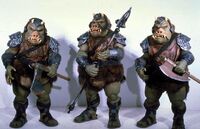
It was honorable for a boar to face an opponent in combat to first blood, defeat or death. Fair tournament fights were usually only to first blood since their purpose was to attract attention and show off not to risk life. Tournaments were also the scenes of pre-arranged death matches, often concerned with a suitor challenging a husband for the right to marry a sow.
The use of "magic" in combat with an honorable opponent was considered dishonorable. In addition to the use of blasters, it also included any other advanced technology, the Force, natural abilities considered magical and anything else that could not be comprehended. It was also dishonorable to kill an opponent stealthily. In Gamorrean society, it was acceptable to challenge an opponent, fight and kill him for no reason at all, but it was an unforgivable wrong to sneak up and kill while they were not looking.
Intellectual thought was moderately discouraged in Gamorrean society and although some used intelligence and strategic planning to win battles, it was generally frowned upon. Sows were generally more intelligent than boars, but it was still not socially acceptable for a sow to be overtly intelligent.
Sows did not commonly fight in pitched battles although they did fight in single combat against raiders and occasionally in duels to settle vendettas. Sows gained honor in Gamorrean society by being gweek, a term that translated as being matronly protective, having many children and tuskers, owning land and property and managing it well.
Regarding working with non-Gamorreans, they also stated that they would only work alongside them, should their opponent best them in single combat, as otherwise, they prefer death to servitude. This was how the first of the Gamorrean guards were recruited under the payroll of Jabba the Hutt, as well as how Thok was recruited by Arden Lyn.
Most Gamorreans had a hatred of droids and other mechanical devices, and they would often needlessly destroy a droid if given the opportunity.
Personal weaponry at a glance
- Arg'garok vibro-axe (mid-range)
- Blaster carbine (long range)
- Cleaver (short range)
- Dueling knife (long range)
- Power gauntlets (special)
- Thogk club (short range)
Language
Rog will not understand this. Who would write Guth's name but Guth? Rog will avenge his brother.Kufbrug struggles to comprehend a forged Gamorrese rune

Gamorreans spoke their native language of Gamorrese, or Gamorrean. To an individual unfamiliar with the language it sounded like a string of grunts, squeals and oinks. It was, however, a complex form of communication well-suited to the lifestyle of the Gamorreans. Although Gamorrese did not have a sophisticated written language, it did have a very basic runic alphabet which was used for record keeping, accounting, recording epic stories, and genealogy. Gamorrean genealogy was an extremely complex subject and was studied by a small class of scholar-lawyer sows who were known to memorize genealogical listings, heroic deeds and property transactions. The runic alphabet was only typically used by educated sows, although a fair number of boars could read them slowly. There were known to be several variations of the runic alphabet. Since most Gamorreans encountered in the galaxy were males, it was generally considered that the Gamorreans had no written language.
Gamorrean names were simple and were generally a guttural word that the individual made up describing what they would do if somebody made them angry. Most other species did not understand the nuances of their names and therefore did not comprehend the meaning intended. Despite this, the Gamorreans continued the practice, perhaps unaware that it was generally their size and demeanor that frightened smaller opponents and not the sound of their name.
Creative arts
The Gamorreans developed a unique music genre called Gamorrean opera, composed of loud grunts, snorts and growls.[14] Another form of music invented by the Gamorreans was called Baka rock[15]. Gamorrean poetry was performed in Hutt-style chuba cantinas nightly in the Mirrsteel Heights on the Kwenn Space Station.[16]
History
How did the Empire capture Gamorr without firing a cannon bolt? They landed backwards, and the Gamorreans thought they were retreating!Jacen Solo
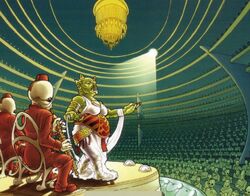
When the first offworld traders landed on Gamorr, five Gamorrean clans fought for the right to approach the vessel. When one clan won the right to approach after two days of battle the victorious Gamorreans walked up to the trading vessel and smashed it into pieces. Six further trading expeditions suffered the same fate before a heavily armed vessel was sent with a new aim, to take the Gamorreans as slaves. After this initial contact, the galaxy found more productive uses for the Gamorreans.
As a result of their physical characteristics and low intelligence, Gamorreans away from their home planet or colony were usually employed as mercenary fighters, guards, bounty hunters or heavy laborers. Gamorreans would generally work for anyone if the price was right and the nature of the work was to their liking. They would even accept slavery if the terms were right. A draw-back for some employers in hiring Gamorreans was their contractual requirements. They generally did not consider a contract binding if it was not sealed in blood by way of combat. Since traditionally a Gamorrean warlord would force a recruit to fight to prove his ability, they expected a prospective employer to do the same. From their perspective if an offworlder could not defeat those that they hired then they were not worth working for. Though prized as mercenaries, their strong clan allegiance and hatred for rival clans made it unwise to hire groups of Gamorrean enforcers without first inquiring about their clan backgrounds. A number of species, including Sullustans, found Gamorrean females attractive, and many found work as belly dancers.[18]
During the Jedi Civil War, Gamorreans were known to be involved with the Exchange[11] and to take innocent beings prisoner, keeping them as slaves, taking particular interest in Wookiees. Gamorrean slavers took Zaalbar prisoner in 3956 BBY, who had to be rescued by an amnesiac Revan.[19] By the time of New Sith Wars, particularly the period between 1042 BBY and 1032 BBY, large numbers of Gamorrean warriors fought alongside Sith troopers under the banner of Sith Lords such as Chagras, Odion and Daiman, participating in raids and massacres. Due to these actions Gamorreans were considered cruel and merciless monsters, and their bad reputation survived into the times of the Galactic Empire. At least one, however, was intelligent and civilized enough to be the sergeant-at-arms for the New Republic Senate.
Gamorrean sows were not as commonly sighted off Gamorr or Pzob. Notable exceptions were female traders such as Ugmush, Captain of the Zicreex, who traveled from Gamorr to nearby worlds trading goods. A Gamorrean sow also performed at the world famous Purghom Musical Performance Hall on Clak'dor VII"[20]. A large group of sows settled on the asteroid G'aav'aar'oon and formed the religious order known as the Nuns of G'aav'aar'oon. They opened their convent as a medical facility, and took a pacifist approach to life, in contrast to the typical Gamorrean philosophy.[21]
Gamorreans in the galaxy
Lord Vader, your powers are improving. See that Gamorrean over there? Kill him.Palpatine walking with Darth Vader while inspecting their workers' progress
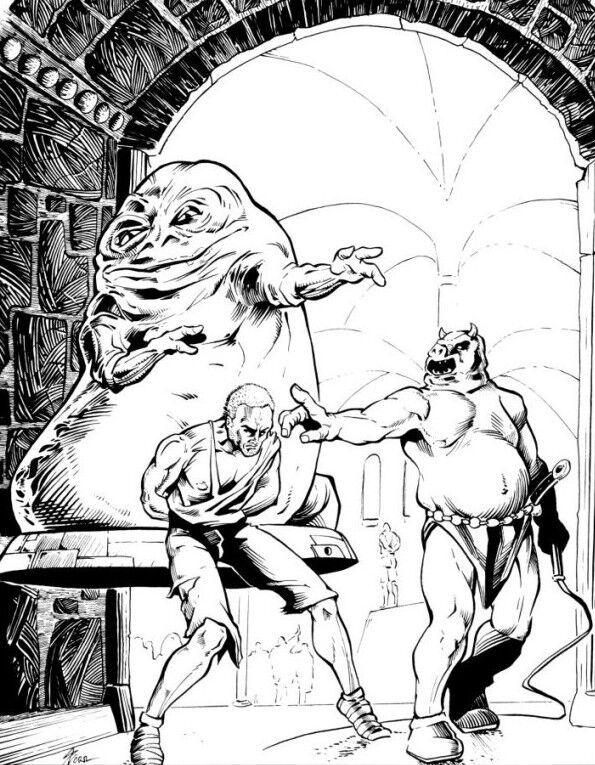
Numerous Hutts employed various Gamorreans throughout the ages. One of them was the intergalactic kingpin of crime, Jabba the Hutt. He was fond of hiring Gamorreans because they were so inexpensive, as well as because their thick mindedness made them immune to dirty tricks such as bribery.[23] Twelve Gamorreans were brought to Tatooine by Han Solo and Chewbacca at the request of Jabba.[24] In order to seal the contract the crimelord agreed to fight them all at once but only if they were blindfolded. They agreed and when they were unable to see Jabba, the Hutt ordered a group of his thugs to beat them. The nine that survived dutifully pledged themselves to the Hutt that they thought gave them a good thrashing.[25] Of the nine surviving, two were named Gartog and Ortugg. Ortugg was the leader of the Gamorreans, who looked down upon Gartogg, the most unintelligent Gamorrean in the palace. Even his fellow Gamorreans shunned him.
Among the Gamorreans in the employ of Jabba the Hutt were Gorc and Thok, brothers imbued with the "magic power" to emit fire from their mouths, in actuality a sign of their Force-sensitivity. In the custody of the darksider Sariss following an incident in Mos Eisley's Red Moon Saloon, Thok revealed his brother's abilities, leading to Gorc's mutation and subsequent membership in Inquisitor Jerec's band of seven Dark Jedi who were looking for the lost Valley of the Jedi.[26] Thok himself was acquired by Emperor's Hand Arden Lyn, who trained the Gamorrean in the art of Teräs Käsi after defeating him in single combat.[27]
Shortly after the reformation of the Republic into the Empire, a Gamorrean laborer worked on the construction of Emperor Palpatine's retreat on the planet Byss. The worker was killed by Darth Vader using the Force at the request of the Emperor".[22]
Gardulla the Hutt also employed Gamorreans. She had about 40 Gamorreans who served her. However, almost none of those Gamorreans survived after Jango Fett infiltrated Gardulla's Palace in 32 BBY. Wartogg was one of the many Gamorrean guards who Jabba put prices on following the capture of Longo Two-Guns. Gardulla was defeated and the Gamorreans that survived were never heard from again.
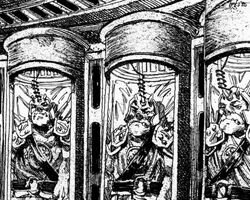
Grappa the Hutt had only one known Gamorrean employed in his service. His name was Tront who, like most of his kind, loathed droids[28]. He ran off with his partner Sol Mon when Rebels came to Grappa's palace. Other Hutts, such as Ka'Pa,[29] also had a few Gamorreans in their employment.
Members of the Klagg and Gakfedd clans native to Pzob were abducted by the battlemoon, the Eye of Palpatine. This vessel had been programmed to pick up stormtroopers who had been implanted onto certain Outer Rim planets but it was disabled by Geith Eris and Callista Ming whose essence remained with the vessel after the Jedi's sacrificed themselves to prevent the assassination of a group of Jedi children on Belsavis. When it was later reactivated 30 years later (12 ABY) the Eye of Palpatine set off to complete its stormtrooper recovery mission. The forty-five stormtroopers deposited on Pzob diminished in numbers over the decades that followed through continual battles with the local Klagg and Gakfedd clans. When the Eye of Palpatine finally arrived the stormtrooper squad was decimated and it took the natives of Pzob in their place. They were forcibly indoctrinated through a cerebral feed and turned into stormtroopers. They wore pieces of stormtrooper armor by cutting out the sleeves or had fastened chunks onto their arms and chests with engine tape. Some of them had stormtrooper helmets perched on the top of their heads like hats.[7]
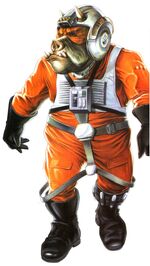
The music band Deeply Religious had a track on their self-titled album called "Gamorrean Hard Case"[30].
One of the most notable Gamorreans was Voort saBinring, nicknamed "Piggy", a member of Wraith Squadron. He joined in 7 ABY and was a member through the Yuuzhan Vong War. As part of Project Chubar he was biochemically altered by Binring Biomedical Product to bring his attention span and intelligence more in line with Humans. When he escaped the facility, he joined the fight against the Empire[31].
As a Wraith, saBinring participated in the fight with Imperial Admiral Apwar Trigit and was an analyst on Han Solo's anti-Zsinj task force. He continued service with the Squadron when it was transferred to New Republic Intelligence. During the Vong invasion, he participated in efforts to repel the Vong from Borleias, as both a Wraith and a member of Twin Suns Squadron. Piggy would also help plan Luke Skywalker's mission to Coruscant to track down Lord Nyax.
After training at some of the finest restaurants on the planet Lamaredd, the male Gamorrean Gammy earned the title of Galactic gourmet. He then went on to teach at the Jedi academy at the Jedi Temple on Coruscant and served as chef.[32]
Behind the scenes
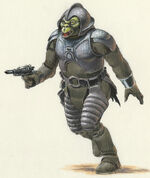
In early sketches of Jabba's Palace guards, Ralph McQuarrie depicted large, aggressive humanoids with the facial features of bears. The design was later developed by Joe Johnston into creatures that resembled wild boars with snouts and tusks. In the original sketches these porcine creatures were wearing no clothing over their torsos. However, due to the limitations of technology in the early 1980s, this was impractical, and the creatures were dressed with the familiar leather and cloth uniform. Metal epaulets were added to the costume to conceal the shoulder seams. The design was refined by Dave Carson, who termed them "Pig Guards," which is what they were called during the production of Return of the Jedi.
In The Dark Side Sourcebook, at the top of page 119, there is an image of what appears to be a Sithspawn Mutant Gamorrean changed by Sith alchemy. It is pictured with what appears to be a mutant Twi'lek, Mon Calamari and Wookiee. The section is about Sith Mutants, but there is no direct reference to the mutant creatures pictured.
Appearances
-
 "Shadows and Light" — Star Wars Tales 23
"Shadows and Light" — Star Wars Tales 23 - Knights of the Old Republic 3
- Knights of the Old Republic 31
- Knights of the Old Republic 39
- Knights of the Old Republic 40
- Star Wars: Knights of the Old Republic
- Star Wars: Knights of the Old Republic II: The Sith Lords
- The Old Republic: Fatal Alliance (and audiobook)
- Star Wars: The Old Republic
- Star Wars: The Old Republic Cartel Market
- The Old Republic: Annihilation (and audiobook)
- Star Wars: The Old Republic: Shadow of Revan
- Star Wars: The Old Republic: Knights of the Fallen Empire
- Star Wars: The Old Republic: Knights of the Eternal Throne
- Knight Errant
- Darth Bane: Path of Destruction (and audiobook) (Mentioned only)
- Darth Plagueis (and audiobook) (Mentioned only)
-
 "Survivors" — Star Wars Tales 13
"Survivors" — Star Wars Tales 13 - Star Wars (1998) 6
- Episode I Adventures 5: The Ghostling Children (and Game Book)
- Episode I Adventures 6: The Hunt for Anakin Skywalker (and Game Book)
- Episode I Adventures 8: Trouble on Tatooine (and Game Book)
- "Darth Maul: Saboteur"
- Darth Maul (2000) 2
- Darth Maul (2000) 3
- Darth Maul (2000) 4
- Darth Maul: Shadow Hunter (and unabridged audiobook)
- Episode I: Queen Amidala
- Star Wars (1998) 9 (Mentioned only)
- Star Wars (1998) 12
- Star Wars (1998) 14
- Star Wars (1998) 15
- Star Wars (1998) 18
- Star Wars: Bounty Hunter
- Star Wars (1998) 20
- Star Wars (1998) 24
- Star Wars (1998) 33
- Star Wars (1998) 36 (In flashback(s))
- Star Wars (1998) 37 (In flashback(s))
- Star Wars (1998) 38 (In flashback(s))
- Star Wars (1998) 39 (In flashback(s))
- Star Wars (1998) 42 (In flashback(s))
-
 "Masquerade" (original article link) on Wizards.com (content now obsolete; backup link)
"Masquerade" (original article link) on Wizards.com (content now obsolete; backup link) - Star Wars Adventures 6: The Warlords of Balmorra (and Game Book)
- Star Wars: Episode II Attack of the Clones novelization (and unabridged audiobook) (Indirect mention only)
- Star Wars: Battlefront II
- Boba Fett: Maze of Deception
- Star Wars: Clone Wars Cine-Manga
-
 Star Wars: Clone Wars — "Chapter 6"
Star Wars: Clone Wars — "Chapter 6" -
 Star Wars: Clone Wars — "Chapter 21"
Star Wars: Clone Wars — "Chapter 21" -
 "Rogue's Gallery" — Star Wars: Clone Wars Adventures Volume 3 (Skull only)
"Rogue's Gallery" — Star Wars: Clone Wars Adventures Volume 3 (Skull only) -
 "Life Below" — Star Wars: Clone Wars Adventures Volume 9
"Life Below" — Star Wars: Clone Wars Adventures Volume 9 - Jedi Trial
- Star Wars: The Clone Wars novelization (and audiobook)
- Boba Fett: Hunted
- The Clone Wars: Crash Course
- The Clone Wars: The Valsedian Operation
-
 Star Wars: The Clone Wars — "Hunt for Ziro"
Star Wars: The Clone Wars — "Hunt for Ziro" - The Clone Wars: Decide Your Destiny: Crisis on Coruscant
-
 Star Wars: The Clone Wars — "Slaves of the Republic"
Star Wars: The Clone Wars — "Slaves of the Republic" -
 Star Wars: The Clone Wars — "Friends and Enemies"
Star Wars: The Clone Wars — "Friends and Enemies" - "Power Down" — Star Wars: The Clone Wars Comic 6.45
-
 Star Wars: The Clone Wars — "Bound for Rescue"
Star Wars: The Clone Wars — "Bound for Rescue" -
 Star Wars: The Clone Wars — "Eminence"
Star Wars: The Clone Wars — "Eminence" - Boba Fett: A New Threat
-
 "Means and Ends" — Star Wars: Clone Wars Adventures Volume 6
"Means and Ends" — Star Wars: Clone Wars Adventures Volume 6 - Star Wars: Revenge of the Sith novelization (and unabridged audiobook) (Mentioned only)
-
 "The Order of Outcasts" — Star Wars: Clone Wars Adventures Volume 5
"The Order of Outcasts" — Star Wars: Clone Wars Adventures Volume 5 - Evasive Action: Recruitment
- Kenobi (and audiobook)
- Coruscant Nights I: Jedi Twilight
- "A Wretched Hive" – Dawn of Defiance campaign
- "The Queen of Air and Darkness" – Dawn of Defiance campaign
- Droids (1986) 1
- The Pirates and the Prince
-
 Star Wars: Droids: The Adventures of R2-D2 and C-3PO — "The Pirates of Tarnoonga"
Star Wars: Droids: The Adventures of R2-D2 and C-3PO — "The Pirates of Tarnoonga" -
 Star Wars: Droids: The Adventures of R2-D2 and C-3PO — "The Revenge of Kybo Ren"
Star Wars: Droids: The Adventures of R2-D2 and C-3PO — "The Revenge of Kybo Ren" - The Paradise Snare
- Star Wars: Droids Special
- Droids (1994) 1
- Droids (1994) 2
- Droids (1994) 6
- Droids (1995) 1
- Droids (1995) 2
- Droids (1995) 4
- Jabba the Hutt: The Gaar Suppoon Hit
- Jabba the Hutt: The Dynasty Trap
- Jabba the Hutt: Betrayal
-
 "The Final Exit" — Star Wars Adventure Journal 4 (also reprinted in The Best of the Star Wars Adventure Journal, Issues 1-4; Tales from the Empire; and Classic Adventures: Volume Four — The Best of the Journal) (Mentioned only)
"The Final Exit" — Star Wars Adventure Journal 4 (also reprinted in The Best of the Star Wars Adventure Journal, Issues 1-4; Tales from the Empire; and Classic Adventures: Volume Four — The Best of the Journal) (Mentioned only) - The Hutt Gambit
- "A Hunter's Fate: Greedo's Tale" — Tales from the Mos Eisley Cantina
-
 "Out of the Cradle" — Star Wars Adventure Journal 2 (also reprinted in Hyperspace: The Official Star Wars Fan Club)
"Out of the Cradle" — Star Wars Adventure Journal 2 (also reprinted in Hyperspace: The Official Star Wars Fan Club) - Agent of the Empire – Iron Eclipse 1
- Death Star (Mentioned only)
- Rebel Dawn
- Adventures in Hyperspace: Shinbone Showdown
- The Abduction (also reprinted in Classic Adventures)
-
 "Infiltration" — Supernova
"Infiltration" — Supernova -
 "You're in the Army Now!" — Star Wars Adventure Journal 2 (also reprinted in Classic Adventures: Volume Four — The Best of the Journal)
"You're in the Army Now!" — Star Wars Adventure Journal 2 (also reprinted in Classic Adventures: Volume Four — The Best of the Journal) -
 "To Hunt the Hutt" — Imperial Entanglements
"To Hunt the Hutt" — Imperial Entanglements -
 "Death-Hunter" — Star Wars Adventure Journal 9 (Mentioned only)
"Death-Hunter" — Star Wars Adventure Journal 9 (Mentioned only) -
 "The Farrimmer Cafe" — Star Wars Adventure Journal 11
"The Farrimmer Cafe" — Star Wars Adventure Journal 11 -
 "Elusive" — No Disintegrations
"Elusive" — No Disintegrations - Rookies: Rendezvous (Mentioned only)
-
 "Snow Job" — Star Wars Gamer 2
"Snow Job" — Star Wars Gamer 2 - Star Wars Adventures: Han Solo and the Hollow Moon of Khorya
- Dark Forces: Soldier for the Empire
- Dark Forces: Soldier for the Empire audio drama (Mentioned only)
- Underworld: The Yavin Vassilika 1
-
 "The Hovel on Terk Street" — Star Wars Tales 6
"The Hovel on Terk Street" — Star Wars Tales 6 - "The Farlander Papers" — Star Wars: X-Wing
- Star Wars: Dark Forces
- Star Wars: Dark Forces Remaster
-
 "A Rancor Comes to Tatooine" — The Star Wars Sourcebook (also reprinted in Second Edition)
"A Rancor Comes to Tatooine" — The Star Wars Sourcebook (also reprinted in Second Edition) - "A Boy and His Monster: The Rancor Keeper's Tale" — Tales from Jabba's Palace
- Star Wars: Cantina
- "Play It Again, Figrin D'an: The Tale of Muftak and Kabe" — Tales from the Mos Eisley Cantina
- "Nightlily: The Lovers' Tale" — Tales from the Mos Eisley Cantina
- "Nightlily: The Lovers' Tale" audio drama
-
 "Spare Parts" — Star Wars Adventure Journal 11 (also reprinted in Hyperspace: The Official Star Wars Fan Club)
"Spare Parts" — Star Wars Adventure Journal 11 (also reprinted in Hyperspace: The Official Star Wars Fan Club) -
 "Once Bitten" — Star Wars Tales 12 (In flashback(s))
"Once Bitten" — Star Wars Tales 12 (In flashback(s)) - Star Wars: Rebellion (Mentioned only)
- Star Wars Missions 2: Escape from Thyferra
-
 "Droid Trouble" — Star Wars Adventure Journal 3 (also reprinted in Hyperspace: The Official Star Wars Fan Club)
"Droid Trouble" — Star Wars Adventure Journal 3 (also reprinted in Hyperspace: The Official Star Wars Fan Club) - Rebel Force: Renegade
-
 "Preparing for War" — The Far Orbit Project
"Preparing for War" — The Far Orbit Project - Star Wars Missions 5: The Hunt for Han Solo
- Scoundrel's Luck
- Jedi's Honor
- Tatooine Manhunt (also reprinted in Classic Adventures: Volume Three)
- Star Wars Missions 12: The Vactooine Disaster
- "The Rebel Thief" — Star Wars Kids (1997) 1—5
- Empire 19
- Allegiance (and audiobook) (Mentioned only)
-
 "Shadow Stalker" — Star Wars Galaxy Magazine 10 (Mentioned only)
"Shadow Stalker" — Star Wars Galaxy Magazine 10 (Mentioned only) - Star Wars 3-D 3
-
 "The Great Herdship Heist" — Star Wars Adventure Journal 15
"The Great Herdship Heist" — Star Wars Adventure Journal 15 - Empire 24
- Empire 25
- Galaxy of Fear: Ghost of the Jedi
- Galaxy of Fear: The Brain Spiders
- Rebellion 0
- Rebellion 6
- Introductory Adventure Game
- Riders of the Maelstrom (also reprinted in Classic Adventures: Volume Three)
-
 "Tales of the Smoking Blaster" — Star Wars Gamemaster Handbook
"Tales of the Smoking Blaster" — Star Wars Gamemaster Handbook -
 "Positive ID" (original article link) on Wizards.com (content now obsolete; backup link)
"Positive ID" (original article link) on Wizards.com (content now obsolete; backup link) -
 "Hunger" (original article link) on Wizards.com (content now obsolete; backup link) (Mentioned only)
"Hunger" (original article link) on Wizards.com (content now obsolete; backup link) (Mentioned only) -
 "Escape from Mos Shuuta" — Star Wars: Edge of the Empire Beginner Game
"Escape from Mos Shuuta" — Star Wars: Edge of the Empire Beginner Game -
 "The Long Arm of the Hutt" — Star Wars: Edge of the Empire Beginner Game
"The Long Arm of the Hutt" — Star Wars: Edge of the Empire Beginner Game -
 "Trouble Brewing" — Star Wars: Edge of the Empire Core Rulebook
"Trouble Brewing" — Star Wars: Edge of the Empire Core Rulebook -
 "Debts to Pay" — Star Wars: Edge of the Empire Game Master's Kit
"Debts to Pay" — Star Wars: Edge of the Empire Game Master's Kit - Scavenger Hunt (Mentioned only)
-
 "All Our Sins Remembered" — Star Wars Gamemaster Kit (also reprinted in Classic Campaigns)
"All Our Sins Remembered" — Star Wars Gamemaster Kit (also reprinted in Classic Campaigns) - Mission to Lianna
- Operation: Elrood
- Galaxy of Fear: The Hunger
-
 "Walking the Path That's Given" — Star Wars Tales 21
"Walking the Path That's Given" — Star Wars Tales 21 - "A Bad Feeling: The Tale of EV-9D9" — Tales from Jabba's Palace
- Imperial Double-Cross
- The Jewel of Yavin
- Star Wars Galaxies: An Empire Divided
- The Game Chambers of Questal (also reprinted in Classic Adventures: Volume Five)
- The Bounty Hunter
-
 "Crimson Bounty" — Star Wars Adventure Journal 14
"Crimson Bounty" — Star Wars Adventure Journal 14 -
 "Laughter After Dark" — Star Wars Adventure Journal 15 (Mentioned only)
"Laughter After Dark" — Star Wars Adventure Journal 15 (Mentioned only) -
 "Lucky Stars" — Star Wars Tales 15
"Lucky Stars" — Star Wars Tales 15 - "Payback: The Tale of Dengar" — Tales of the Bounty Hunters
- "And the Band Played On: The Band's Tale" — Tales from Jabba's Palace
- Star Wars: Demolition
- Star Wars: Shadows of the Empire novel
- Battle of the Bounty Hunters
- Shadows of the Empire 4
- Shadows of the Empire 6
-
 "The Employment Test" — Galaxy Guide 5: Return of the Jedi (also reprinted in Second Edition and The Movie Trilogy Sourcebook) (Mentioned only)
"The Employment Test" — Galaxy Guide 5: Return of the Jedi (also reprinted in Second Edition and The Movie Trilogy Sourcebook) (Mentioned only) - "That's Entertainment: The Tale of Salacious Crumb" — Tales from Jabba's Palace
- "Of the Day's Annoyances: Bib Fortuna's Tale" — Tales from Jabba's Palace
- Return of the Jedi radio drama — "Tatooine Haunts"
- Star Wars: Episode VI Return of the Jedi
- Star Wars: Return of the Jedi novelization (and unabridged audiobook) (First appearance, in book)
- Star Wars: Episode VI Return of the Jedi junior novelization
- Return of the Jedi 1 (colorized in Star Wars: Episode VI — Return of the Jedi)
- "Taster's Choice: The Tale of Jabba's Chef" — Tales from Jabba's Palace
- "A Time to Mourn, a Time to Dance: Oola's Tale" — Tales from Jabba's Palace
- "Goatgrass: The Tale of Ree-Yees" — Tales from Jabba's Palace
- "And Then There Were Some: The Gamorrean Guard's Tale" — Tales from Jabba's Palace
- "Let Us Prey: The Whiphid's Tale" — Tales from Jabba's Palace
- "Tongue-tied: Bubo's Tale" — Tales from Jabba's Palace
- Return of the Jedi radio drama — "Fast Friends"
- "A Free Quarren in the Palace: Tessek's Tale" — Tales from Jabba's Palace
- "Sleight of Hand: The Tale of Mara Jade" — Tales from Jabba's Palace
- "Old Friends: Ephant Mon's Tale" — Tales from Jabba's Palace
- Mara Jade – By the Emperor's Hand 1
- Return of the Jedi 2 (colorized in Star Wars: Episode VI — Return of the Jedi)
- "Skin Deep: The Fat Dancer's Tale" — Tales from Jabba's Palace
- The Mandalorian Armor (Mentioned only)
- Slave Ship (Mentioned only)
-
 "The Ordeal of Boba Fett" — Dark Empire Sourcebook (Mentioned only)
"The Ordeal of Boba Fett" — Dark Empire Sourcebook (Mentioned only) - Star Wars (1977) 81 (colorized in Star Wars: A Long Time Ago... Volume 5: Fool's Bounty) (In flashback(s))
- Star Wars (1977) 85 (colorized in Star Wars: A Long Time Ago... Volume 6: Wookiee World)
- Star Wars (1977) 90 (colorized in Star Wars: A Long Time Ago... Volume 6: Wookiee World)
-
 "Three Against the Galaxy" — Star Wars Tales 3
"Three Against the Galaxy" — Star Wars Tales 3 - "The Jabba Tape"
- Star Wars (1977) 108
- Dark Forces: Rebel Agent
- Dark Forces: Rebel Agent audio drama
- Star Wars: Jedi Knight: Dark Forces II
-
 "The One That Got Away" — Star Wars Tales 8
"The One That Got Away" — Star Wars Tales 8 -
 "The Right Place ..." — The Politics of Contraband (also reprinted in Classic Adventures)
"The Right Place ..." — The Politics of Contraband (also reprinted in Classic Adventures) -
 "Easy Money" — The Politics of Contraband (also reprinted in Classic Adventures)
"Easy Money" — The Politics of Contraband (also reprinted in Classic Adventures) -
 "Heroes Need Not Apply" — Star Wars Adventure Journal 12
"Heroes Need Not Apply" — Star Wars Adventure Journal 12 -
 "For a Few Kilotons More" — Twin Stars of Kira
"For a Few Kilotons More" — Twin Stars of Kira - X-Wing: Rogue Squadron (and unabridged audiobook) (Mentioned only)
- X-Wing: Wedge's Gamble (and unabridged audiobook)
- X-Wing: Wraith Squadron (and unabridged audiobook)
- X-Wing: Iron Fist (and unabridged audiobook)
- X-Wing: Solo Command (and unabridged audiobook)
-
 "Little Empires" — The Kathol Outback (Reprinted and collected in The DarkStryder Campaign, Deluxe) (Picture only)
"Little Empires" — The Kathol Outback (Reprinted and collected in The DarkStryder Campaign, Deluxe) (Picture only) - "Hutt and Seek" — Tales from the New Republic (Mentioned only)
- Tatooine Ghost
- Heir to the Empire (and unabridged audiobook) (Mentioned only)
- X-Wing: Isard's Revenge (Mentioned only)
- Star Wars: Jedi Knight: Mysteries of the Sith
- Crimson Empire II: Council of Blood 1
- Crimson Empire II: Council of Blood 5
- I, Jedi (and unabridged audiobook) (Mentioned only)
- Children of the Jedi
- "Simple Tricks" — Tales from the New Republic (Mentioned only)
- Darksaber
-
 "Murder in Slushtime" — Star Wars Adventure Journal 14 (also reprinted in Hyperspace: The Official Star Wars Fan Club)
"Murder in Slushtime" — Star Wars Adventure Journal 14 (also reprinted in Hyperspace: The Official Star Wars Fan Club) - Planet of Twilight
- Before the Storm
-
 "Red Sky, Blue Flame" — Star Wars Gamer 7 (Mentioned only)
"Red Sky, Blue Flame" — Star Wars Gamer 7 (Mentioned only) - Young Jedi Knights: Diversity Alliance
- Young Jedi Knights: Delusions of Grandeur
- Young Jedi Knights: Jedi Bounty
- Young Jedi Knights: The Emperor's Plague
- Young Jedi Knights: Crisis at Crystal Reef (Mentioned only)
- The New Jedi Order: Vector Prime
- The New Jedi Order: Dark Tide I: Onslaught
- The New Jedi Order: Agents of Chaos I: Hero's Trial
- The New Jedi Order: Agents of Chaos II: Jedi Eclipse
- The New Jedi Order: Balance Point
- The New Jedi Order: Edge of Victory I: Conquest (Mentioned only)
- The New Jedi Order: Edge of Victory II: Rebirth
- The New Jedi Order: Star by Star (Mentioned only)
- The New Jedi Order: Dark Journey (Mentioned only)
- The New Jedi Order: Enemy Lines I: Rebel Dream
- The New Jedi Order: Enemy Lines II: Rebel Stand
- The New Jedi Order: The Unifying Force
- Dark Nest I: The Joiner King (Mentioned only)
- Legacy of the Force: Tempest
- Legacy of the Force: Exile (Mentioned only)
- Legacy of the Force: Invincible (Mentioned only)
- Millennium Falcon (and audiobook)
- Fate of the Jedi: Outcast (and audiobook) (Mentioned only)
- Fate of the Jedi: Omen (and audiobook)
- Fate of the Jedi: Backlash (and audiobook) (as a disguise)
- Fate of the Jedi: Allies (and audiobook)
- Fate of the Jedi: Vortex (and audiobook) (Mentioned only)
- Fate of the Jedi: Conviction (and audiobook)
- Fate of the Jedi: Ascension (and audiobook) (Mentioned only)
- X-Wing: Mercy Kill (and audiobook)
- Legacy (2006) 11
Non-canon appearances
-
 "Skippy the Jedi Droid" — Star Wars Tales 1
"Skippy the Jedi Droid" — Star Wars Tales 1 -
 "Fortune, Fate, and the Natural History of the Sarlacc" — Star Wars Tales 6
"Fortune, Fate, and the Natural History of the Sarlacc" — Star Wars Tales 6 -
 "Skreej" — Star Wars Tales 10
"Skreej" — Star Wars Tales 10 - ° Star Wars Infinities: The Empire Strikes Back
-
 "Mythology" — Star Wars Tales 14 (In flashback(s))
"Mythology" — Star Wars Tales 14 (In flashback(s)) -
 "Best Birthday Ever" — Star Wars Tales 16
"Best Birthday Ever" — Star Wars Tales 16 - ° Star Wars Infinities: Return of the Jedi
-
 "The Lost Lightsaber" — Star Wars Tales 19 (In flashback(s))
"The Lost Lightsaber" — Star Wars Tales 19 (In flashback(s)) -
 "Fett Club" — Star Wars Tales 24
"Fett Club" — Star Wars Tales 24 - The Return of Tag & Bink: Special Edition
- LEGO Star Wars II: The Original Trilogy
- LEGO Star Wars: The Complete Saga
- Star Wars: The Force Unleashed — Ultimate Sith Edition
- LEGO Star Wars: The Yoda Chronicles video game
- Jedi Academy: Return of the Padawan
- Star Wars Mythos (canceled)
Sources
- Return of the Jedi Monster Activity Book
- Star Wars: Return of the Jedi Coloring Book (Luke Skywalker)
- Star Wars: Return of the Jedi Coloring Book (Max Rebo)
-
Star Wars: Return of the Jedi (Pack: Gamorrean Guard) (backup link)
- A Guide to the Star Wars Universe
- Star Wars: Return of the Jedi Coloring Book (1984) (Picture only)
- The Star Wars Sourcebook
-
 "Mark Hamill: 10 Years Later" — The Lucasfilm Fan Club Magazine 3 (Picture only)
"Mark Hamill: 10 Years Later" — The Lucasfilm Fan Club Magazine 3 (Picture only) - Star Wars Campaign Pack
- The Star Wars Rules Companion
- Galaxy Guide 2: Yavin and Bespin
- Star Wars Miniatures Battles, First Edition
- Galaxy Guide 5: Return of the Jedi
-
 "The Nuns of G'aav'aar'oon" — Challenge 43 (Unlicensed)
"The Nuns of G'aav'aar'oon" — Challenge 43 (Unlicensed) - Galaxy Guide 6: Tramp Freighters
- Planets of the Galaxy, Volume One
- Star Wars: The Roleplaying Game, Second Edition
- Star Wars Gamemaster Screen
- Galaxy Guide 7: Mos Eisley
- Galaxy Guide 9: Fragments from the Rim
- Dark Empire Sourcebook
- Wanted by Cracken
- Star Wars Gamemaster Handbook
- Planets of the Galaxy, Volume Three
- The Movie Trilogy Sourcebook
- Star Wars Technical Journal of the Planet Tatooine (Picture only)
- Star Wars Miniatures Battles, Second Edition
- Galaxy Guide 10: Bounty Hunters
- Galaxy Guide 6: Tramp Freighters, Second Edition
- Creatures of the Galaxy
- The Star Wars Sourcebook, Second Edition
- Galaxy Guide 11: Criminal Organizations
- The Star Wars Planets Collection
-
 "Wanted by Cracken" — Star Wars Adventure Journal 4
"Wanted by Cracken" — Star Wars Adventure Journal 4 -
 "New Character Templates: A Supplement to Star Wars' Mos Eisley Galaxy Guide" — Challenge 73 (Unlicensed)
"New Character Templates: A Supplement to Star Wars' Mos Eisley Galaxy Guide" — Challenge 73 (Unlicensed) - Dark Forces Manual: Coded Transmissions
- Platt's Starport Guide
- Star Wars Technical Journal (Picture only)
- Galladinium's Fantastic Technology
- Star Wars Galaxy Magazine 3
- Dark Forces Official Player's Guide
- Alliance Intelligence Reports
- Star Wars Galaxy Magazine 5
- The Essential Guide to Characters
- Star Wars Gamemaster Screen, Revised
-
 "Wanted by Cracken" — Star Wars Adventure Journal 8
"Wanted by Cracken" — Star Wars Adventure Journal 8 - The Illustrated Star Wars Universe
- Heroes & Rogues
- Galaxy Guide 2: Yavin and Bespin, Second Edition
- Galaxy Guide 5: Return of the Jedi, Second Edition
- ° Star Wars: The Power of the Force toy line (1995)
-
 "A Free-Trader's Guide to the Planets" — Star Wars Adventure Journal 10
"A Free-Trader's Guide to the Planets" — Star Wars Adventure Journal 10 - Shadows of the Empire Sourcebook
- Live-Action Adventures
- Star Wars: The Roleplaying Game, Second Edition, Revised and Expanded
-
1996 Topps Star Wars: Shadows of the Empire (Card: Guri Does Xizor's Dirty Work) (backup link)
- Return of the Jedi: The National Public Radio Dramatization
-
 "Smuggler's Log" — Star Wars Adventure Journal 11
"Smuggler's Log" — Star Wars Adventure Journal 11 - Gamemaster Toolkit: Live-Action Adventures
- Pirates & Privateers
- Wretched Hives of Scum & Villainy
- The Black Sands of Socorro
- Lords of the Expanse
- Secrets of the Sisar Run
- Star Wars Trilogy Sourcebook, Special Edition
- The Essential Guide to Weapons and Technology
- Star Wars: The Art of the Brothers Hildebrandt
- Platt's Smugglers Guide
- Star Wars: The Action Figure Archive
-
 "Who Is That Alien?" — Star Wars Kids (1997) 8
"Who Is That Alien?" — Star Wars Kids (1997) 8 - Star Wars: Rebellion: Prima's Official Strategy Guide (Picture only)
-
 Star Wars Customizable Card Game — Jabba's Palace Limited (Card: Gamorrean Guard) (backup link)
Star Wars Customizable Card Game — Jabba's Palace Limited (Card: Gamorrean Guard) (backup link) - Star Wars Encyclopedia
- Alien Encounters
- The Essential Guide to Planets and Moons
- Star Wars: Behind the Magic
- Star Wars: The Visual Dictionary
- The Essential Guide to Droids (Mentioned only)
- Star Wars Roleplaying Game Core Rulebook
- The Essential Guide to Alien Species
- The Dark Side Sourcebook
-
 "Rogues Gallery: Fringers" — Star Wars Gamer 7 (Picture only)
"Rogues Gallery: Fringers" — Star Wars Gamer 7 (Picture only) -
 "Who's Who in the New Jedi Order" — Star Wars Insider 57
"Who's Who in the New Jedi Order" — Star Wars Insider 57 -
 Star Wars: Power of the Jedi (Pack: Tessek) (backup link)
Star Wars: Power of the Jedi (Pack: Tessek) (backup link) - The Official Star Wars Fact File 2 (GAM 1-4: Gamorreans)
- The Official Star Wars Fact File 2 (DEJ 1-2: Dejarik Hologame)
- Star Wars Roleplaying Game Revised Core Rulebook
-
 "The Ultimate Return of the Jedi Insider's Guide" — Star Wars Insider 67
"The Ultimate Return of the Jedi Insider's Guide" — Star Wars Insider 67 -
 "Who's Who in the Max Rebo Band" — Star Wars Insider 67
"Who's Who in the Max Rebo Band" — Star Wars Insider 67 - Ultimate Alien Anthology
- The Official Star Wars Fact File 75 (MAX 7-10: Max Rebo Band)
- Star Wars: Knights of the Old Republic: Prima's Official Strategy Guide
- Galactic Campaign Guide
- Star Wars Galaxies: An Empire Divided Quick Reference Guide
- Geonosis and the Outer Rim Worlds
- Ultimate Adversaries
![]() Star Wars Miniatures — Rebel Storm
Star Wars Miniatures — Rebel Storm
-
 Drawing a Gamorrean Guard on StarWars.com (content now obsolete; backup link)
Drawing a Gamorrean Guard on StarWars.com (content now obsolete; backup link) -
 Photoreceptor - Gamorrean Flirt on Hyperspace (content obsolete and backup link not available)
Photoreceptor - Gamorrean Flirt on Hyperspace (content obsolete and backup link not available) - Star Wars: Knights of the Old Republic II: The Sith Lords: Prima Official Game Guide
-
 "Fringe Benefits" on Wizards.com (content now obsolete; backup link)
"Fringe Benefits" on Wizards.com (content now obsolete; backup link) -
 Photoreceptor - The Other Green Meat on Hyperspace (content obsolete and backup link not available)
Photoreceptor - The Other Green Meat on Hyperspace (content obsolete and backup link not available) -
 "The Dark Forces Saga, Part 1" (original article link) on Wizards.com (content now obsolete; backup link)
"The Dark Forces Saga, Part 1" (original article link) on Wizards.com (content now obsolete; backup link) -
 Photoreceptor - Pig's Features on Hyperspace (content obsolete and backup link not available)
Photoreceptor - Pig's Features on Hyperspace (content obsolete and backup link not available) -
 Photoreceptor - Awkward Party on Hyperspace (content obsolete and backup link not available)
Photoreceptor - Awkward Party on Hyperspace (content obsolete and backup link not available) - Star Wars: The Official Figurine Collection 20
![]() Star Wars Miniatures — Bounty Hunters
Star Wars Miniatures — Bounty Hunters
- The New Essential Guide to Alien Species
- Star Wars Roleplaying Game Saga Edition Core Rulebook
- Knights of the Old Republic Campaign Guide
-
 Star Wars Galaxies Trading Card Game — Champions of the Force (Card: Stamina) (backup link) (Picture only)
Star Wars Galaxies Trading Card Game — Champions of the Force (Card: Stamina) (backup link) (Picture only) - Star Wars Fandex Deluxe Edition
- The Complete Star Wars Encyclopedia
-
 Concept Art – Gamorreans on The Old Republic's official website (link obsolete; content only found on older version of webpage: backup link)
Concept Art – Gamorreans on The Old Republic's official website (link obsolete; content only found on older version of webpage: backup link) -
 Star Wars Galaxies Trading Card Game — Squadrons Over Corellia (Card: Gamorrean Battleaxe) (backup link)
Star Wars Galaxies Trading Card Game — Squadrons Over Corellia (Card: Gamorrean Battleaxe) (backup link) -
2009 Topps Star Wars Galaxy Series 4 (Card: Pronovost sketch card)
- Rebellion Era Campaign Guide
- Galaxy at War
-
 Friday Feature – The Return of the Galactic Moon Festival on the official Star Wars Galaxies website (content now obsolete; backup link)
Friday Feature – The Return of the Galactic Moon Festival on the official Star Wars Galaxies website (content now obsolete; backup link) -
 Xim Week: The Despotica (Part IV: Evocar) on Hyperspace (article) (content obsolete and backup link not available)
Xim Week: The Despotica (Part IV: Evocar) on Hyperspace (article) (content obsolete and backup link not available) -
2010 Topps Star Wars Galaxy Series 5 (Card: Pronovost sketch card)
-
2011 Topps Star Wars Galaxy Series 6 (Card: Pronovost sketch card)
- Star Wars: Head-to-Head Tag Teams
-
 Ak-rev in the Databank (content now obsolete; backup link)
Ak-rev in the Databank (content now obsolete; backup link) -
 Bodonawieedo, Doda in the Databank (content now obsolete; backup link)
Bodonawieedo, Doda in the Databank (content now obsolete; backup link) -
 Gamorrean in the Databank (content now obsolete; backup link)
Gamorrean in the Databank (content now obsolete; backup link) -
 Jabba the Hutt in the Databank (content now obsolete; backup link)
Jabba the Hutt in the Databank (content now obsolete; backup link) -
 Jabba the Hutt's Palace in the Databank (content now obsolete; backup link)
Jabba the Hutt's Palace in the Databank (content now obsolete; backup link) -
 Nilo in the Databank (content now obsolete; backup link)
Nilo in the Databank (content now obsolete; backup link) -
 Oola in the Databank (content now obsolete; backup link)
Oola in the Databank (content now obsolete; backup link) -
 rancor in the Databank (content now obsolete; backup link)
rancor in the Databank (content now obsolete; backup link) -
 Ree-Yees in the Databank (content now obsolete; backup link)
Ree-Yees in the Databank (content now obsolete; backup link) -
 Vao, Mission in the Databank (content now obsolete; backup link)
Vao, Mission in the Databank (content now obsolete; backup link) -
 vibro-ax in the Databank (content now obsolete; backup link)
vibro-ax in the Databank (content now obsolete; backup link) -
 Zaalbar in the Databank (content now obsolete; backup link)
Zaalbar in the Databank (content now obsolete; backup link) - Star Wars: The Clone Wars The Complete Season Three
- Star Wars: The Old Republic Explorer's Guide
- Star Wars: The Ultimate Visual Guide: Updated and Expanded
- The Essential Reader's Companion
- Star Wars: The Old Republic Encyclopedia
- Star Wars: Edge of the Empire Beginner Game
-
 Star Wars: The Card Game — Core Set (Card: Return of the Jedi) (Picture only)
Star Wars: The Card Game — Core Set (Card: Return of the Jedi) (Picture only) - Star Wars: Edge of the Empire Core Rulebook
- Star Wars: Edge of the Empire Game Master's Kit
-
 Star Wars: The Card Game — Edge of Darkness (Card: Gamorrean Guard)
Star Wars: The Card Game — Edge of Darkness (Card: Gamorrean Guard) -
 Star Wars: The Card Game — Edge of Darkness (Card: Prized Possession) (Picture only)
Star Wars: The Card Game — Edge of Darkness (Card: Prized Possession) (Picture only)
-
 Barely Tolerable: Alien Henchmen of the Empire, Part 2 on StarWars.com (article) (content now obsolete; backup link)
Barely Tolerable: Alien Henchmen of the Empire, Part 2 on StarWars.com (article) (content now obsolete; backup link) -
 So Uncivilized: Great Gunslingers in Star Wars, Part 1 on StarWars.com (article) (content now obsolete; backup link)
So Uncivilized: Great Gunslingers in Star Wars, Part 1 on StarWars.com (article) (content now obsolete; backup link) -
 "From Page to Screen and Back Again..." — Star Wars Insider 145
"From Page to Screen and Back Again..." — Star Wars Insider 145 -
 Slugthrowers: An Overview of Popular Music and Musicians in a Galaxy Far, Far Away, Part 1 on StarWars.com (article) (content now obsolete; backup link)
Slugthrowers: An Overview of Popular Music and Musicians in a Galaxy Far, Far Away, Part 1 on StarWars.com (article) (content now obsolete; backup link) - Enter the Unknown
- Suns of Fortune
- Dangerous Covenants
- Star Wars: What Makes a Monster?
- Star Wars: Age of Rebellion Core Rulebook
- Far Horizons
-
 Star Wars: The Card Game — Darkness and Light (Card: Chain Reaction) (Picture only)
Star Wars: The Card Game — Darkness and Light (Card: Chain Reaction) (Picture only) -
 Star Wars: The Card Game — Darkness and Light (Card: Palace Security) (Picture only)
Star Wars: The Card Game — Darkness and Light (Card: Palace Security) (Picture only) -
 Star Wars: The Card Game — Darkness and Light (Card: Prized Possession) (Picture only)
Star Wars: The Card Game — Darkness and Light (Card: Prized Possession) (Picture only) -
 Star Wars: The Card Game — Darkness and Light (Card: The Slimiest Scheme) (Picture only)
Star Wars: The Card Game — Darkness and Light (Card: The Slimiest Scheme) (Picture only)
- (Picture only)
-
 Star Wars: The Card Game — Between the Shadows (Card: Prized Possession) (Picture only)
Star Wars: The Card Game — Between the Shadows (Card: Prized Possession) (Picture only) - Lords of Nal Hutta
- Fly Casual
-
 Star Wars™: The Old Republic™ - Road Map 2017 on The Old Republic's official website (backup link)
Star Wars™: The Old Republic™ - Road Map 2017 on The Old Republic's official website (backup link) -
 Kick off your 'Summer of SWTOR'! on The Old Republic's official website (backup link)
Kick off your 'Summer of SWTOR'! on The Old Republic's official website (backup link) -
 SWTOR In-Game Events for July on The Old Republic's official website (backup link)
SWTOR In-Game Events for July on The Old Republic's official website (backup link) -
 SWTOR In-Game Events for July on The Old Republic's official website (backup link)
SWTOR In-Game Events for July on The Old Republic's official website (backup link) -
 SWTOR In-Game Events for August on The Old Republic's official website (backup link)
SWTOR In-Game Events for August on The Old Republic's official website (backup link)
Notes and references
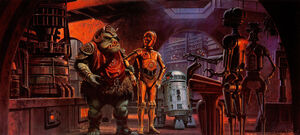
- ↑ The Essential Atlas
- ↑ Star Wars: Head-to-Head Tag Teams
- ↑ Star Wars: Episode VI Return of the Jedi"
- ↑ 4.0 4.1 4.2 4.3 4.4 4.5 4.6
 "Murder in Slushtime" — Star Wars Adventure Journal 14
"Murder in Slushtime" — Star Wars Adventure Journal 14
- ↑ Wretched Hives of Scum & Villainy
- ↑
 Star Wars: The Old Republic: Legacy of the Sith — Mission: "The Path Below" on Hutta
Star Wars: The Old Republic: Legacy of the Sith — Mission: "The Path Below" on Hutta
- ↑ 7.0 7.1 Children of the Jedi
- ↑ Star Wars: Outlander
- ↑ Alliance Intelligence Reports
- ↑ The New Essential Guide to Alien Species
- ↑ 11.0 11.1 Star Wars: Knights of the Old Republic II: The Sith Lords
- ↑ The Essential Guide to Weapons and Technology
- ↑
 Star Wars Customizable Card Game — Jabba's Palace Limited (no cardname specified!)
Star Wars Customizable Card Game — Jabba's Palace Limited (no cardname specified!)
- ↑
 "The Long Arm of the Hutt" — Star Wars: Edge of the Empire Beginner Game
"The Long Arm of the Hutt" — Star Wars: Edge of the Empire Beginner Game
- ↑
 Slugthrowers: An Overview of Popular Music and Musicians in a Galaxy Far, Far Away, Part 1 on StarWars.com (article) (content now obsolete; backup link)
Slugthrowers: An Overview of Popular Music and Musicians in a Galaxy Far, Far Away, Part 1 on StarWars.com (article) (content now obsolete; backup link)
- ↑ Lords of Nal Hutta
- ↑ Legacy of the Force: Invincible
- ↑ "Nightlily: The Lovers' Tale" — Tales from the Mos Eisley Cantina
- ↑ Star Wars: Knights of the Old Republic
- ↑ Geonosis and the Outer Rim Worlds
- ↑
 "The Nuns of G'aav'aar'oon" — Challenge 43
"The Nuns of G'aav'aar'oon" — Challenge 43
- ↑ 22.0 22.1 Evasive Action: Recruitment
- ↑ Star Wars: The Visual Dictionary
- ↑ The Essential Guide to Alien Species
- ↑ The Essential Guide to Characters
- ↑ Star Wars: Jedi Knight: Dark Forces II
- ↑
 Barely Tolerable: Alien Henchmen of the Empire, Part 2 on StarWars.com (article) (content now obsolete; backup link)
Barely Tolerable: Alien Henchmen of the Empire, Part 2 on StarWars.com (article) (content now obsolete; backup link)
- ↑ Star Wars: Crimson Empire II: Council of Blood
- ↑ Star Wars: Jedi Knight: Mysteries of the Sith
- ↑ Galaxy Guide 9: Fragments from the Rim
- ↑ X-Wing: Wraith Squadron
- ↑ Jedi Academy: Return of the Padawan
External links
-
Gamorrean Guard action figure 2004 in the StarWars.com Cargo Bay (content now obsolete; backup link)
-
Gamorrean Guard Galactic Heroes figure 2004 in the StarWars.com Cargo Bay (content now obsolete; backup link)
-
Gamorrean Guard action figure 1997 in the StarWars.com Cargo Bay (content now obsolete; backup link)
-
Gamorrean Guard action figure 1983 in the StarWars.com Cargo Bay (content now obsolete; backup link)
-
LEGO Gamorrean Guard minifigure 2003 in the StarWars.com Cargo Bay (content now obsolete; backup link)
-
Gamorrean Guard 12" action figure 2003 in the StarWars.com Cargo Bay (content now obsolete; backup link)
